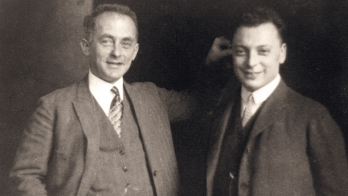by Leonard Susskind, Little Brown and Company. Hardback ISBN 9780316016407, $27.99.
Despite appearances, you will not encounter Stephen Hawking in an armoured wheel chair, Lenny Susskind wearing a short spade and a net, or Gerard ’t Hooft with a spear and a shield; all three in the gladiator’s arena. This book contains a lot of drama, but most of it happens in the heads of these physicists and in their discussions. All three, the main characters of the book, are good friends and respect each other profoundly.
In the 1970s Hawking studied quantum mechanics near black holes and made the remarkable discovery that they are not black after all. They radiate energy with an apparently thermal spectrum, the temperature of which is inversely proportional to the mass of the hole. For the black holes that occur in nature at the centre of galaxies, or as the final products of the deaths of supermassive stars, this radiation is completely negligible. So, what was the point? Elaborating on his computations, Hawking concluded that in this process, if some information is gobbled up by the hole once it passes its event horizon, it will be forever lost. There is no way to retrieve it.
This was the starting shot in the war, and what a shot it was. As Susskind explains in great detail, it rocked the boat of physics so badly that it almost caused it to sink.

The claim was made in the late 1970s but ’t Hooft and Susskind learnt about it in a special meeting in 1981, in the attic of Werner Erhard (of “est” fame). Many physicists at the time dismissed the problem, but our two heroes recognized the mortal blow that it represented to the heart of quantum mechanics. A basic feature in the quantum description of nature is the conservation of information. In more technical terms, we believe that no matter how complex a process, it will never violate the unitarity of quantum evolution in time. The formation of a black hole out of ordinary stuff – and its subsequent evaporation – should not represent an exception despite its complexity. Hawking put his finger on a fundamental issue that hindered the possible unification of general relativity and quantum mechanics, which was a major preoccupation of Albert Einstein and many after him.
Hawking had clearly won, by surprise, the first battle. This we learn at the beginning of the book. The rest describes Susskind’s strategy of attrition until he could claim victory a quarter of a century later.
In sharing the author’s path to victory you will learn a lot of deep physics: the basis of quantum mechanics; the fundamental characteristics of black holes; the need to use string theory and some of its tools developed in the 1990s – arcane notions such as the principles of black-hole complementarity, the discovery of D-branes by Joe Polchinski and, above all, the holographic principle that appeared first in the study of the problem by Susskind and ’t Hooft, but that was masterfully formulated in string theory by Juan Maldacena. There are many other heroes in this story: Strominger, Vafa, Sen, Witten, Callan, Horowitz, Giddings, Harvey, Thorlacius and Russo etc. – who all provided the ammunition necessary to demolish Hawking’s edifice, to the point that he surrendered by around 2003.
In parts three and four of the book, the going gets necessarily rough. The ideas are deeply unfamiliar and one may from time to time feel some form of mental saturation. Being a consummate storyteller, the author punctuates the more difficult passages with a good deal of irreverent and iconoclastic humour. Read the chapter “Ahab in Cambridge”. His description of life and academia in Cambridge, England, is hilarious. Indeed, throughout the book you will get a good number of laughs.
In all, the book presents a fascinating and intellectual adventure in accessible terms where you can learn some of the more challenging ideas in modern theoretical physics. The author follows to the letter Einstein’s mandate of making things as simple as possible, but not simpler. It is original, honest, profound and fun. You could hardly ask for more.







